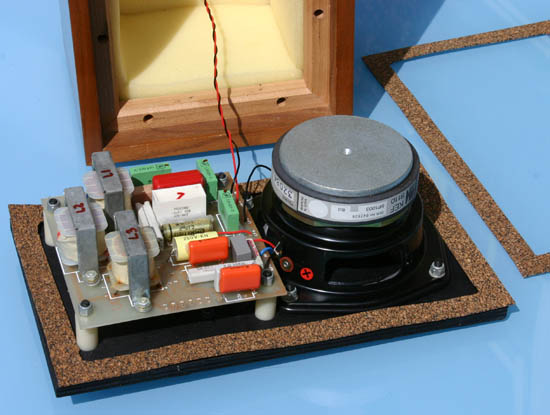Hi all,
Been a while since I bored you guys with some input, but this I had to share.
Yesterday, having a day off, I popped into my dealer's in Ghent. Nice music playing; probably the Avantgarde horns, I heard myself think.
No, rather average looking box-speakers, with a funky red baffle. Some new, top of the line actives apparently!
No, plain, ported, passive two-ways.
Russell K is the name, after Russell Kaufman, who worked for Morel, Wharfedale, B&W and Monitor Audio, until he founded his own company recently. The man has a very refreshing look in speaker design, using thin wall cabinets, braced but without internal damping. A minimalist cross-over is applied, combined with the drivers' mechanical roll-off.
I heard the Red 100, which, finished in standard grey, with red baffle and without grille, sells for EUR 1495 per pair.
You can have the speakers with black baffles too, veneered or in piano gloss black, and with grilles if you like. All paying extras, adding upto EUR 500 to the price, but only if you feel you need them.
This couple sounds amazing!They're fast (a major quality in my book) and vivid and produce very convincing timbres in voices and acoustic instruments like piano or plucked guitars. And their bass rendition is surprising for their size. They remind me of Harbeths, only more open and dynamic... And about half the price (if you don't mind the personal but rather plain finish)!
I imagine they shouldn't be difficult to position in an average room either, being front ported.
And though I heard them, coupled to an Accuphase E600 (not quite price-matched!), they're supposed to be rather easy to drive, with a very friendly impedance curve.
Bottom line: if you're looking for a pair of speakers in the 1500 - 4000 EUR price bracket, start googling for the closest dealer now. Go and listen. And be prepared to be amazed!
A game changer? You bet! (all in my humblest of opinions, of course)
Been a while since I bored you guys with some input, but this I had to share.
Yesterday, having a day off, I popped into my dealer's in Ghent. Nice music playing; probably the Avantgarde horns, I heard myself think.
No, rather average looking box-speakers, with a funky red baffle. Some new, top of the line actives apparently!
No, plain, ported, passive two-ways.
Russell K is the name, after Russell Kaufman, who worked for Morel, Wharfedale, B&W and Monitor Audio, until he founded his own company recently. The man has a very refreshing look in speaker design, using thin wall cabinets, braced but without internal damping. A minimalist cross-over is applied, combined with the drivers' mechanical roll-off.
I heard the Red 100, which, finished in standard grey, with red baffle and without grille, sells for EUR 1495 per pair.
You can have the speakers with black baffles too, veneered or in piano gloss black, and with grilles if you like. All paying extras, adding upto EUR 500 to the price, but only if you feel you need them.
This couple sounds amazing!They're fast (a major quality in my book) and vivid and produce very convincing timbres in voices and acoustic instruments like piano or plucked guitars. And their bass rendition is surprising for their size. They remind me of Harbeths, only more open and dynamic... And about half the price (if you don't mind the personal but rather plain finish)!
I imagine they shouldn't be difficult to position in an average room either, being front ported.
And though I heard them, coupled to an Accuphase E600 (not quite price-matched!), they're supposed to be rather easy to drive, with a very friendly impedance curve.
Bottom line: if you're looking for a pair of speakers in the 1500 - 4000 EUR price bracket, start googling for the closest dealer now. Go and listen. And be prepared to be amazed!
A game changer? You bet! (all in my humblest of opinions, of course)











